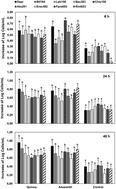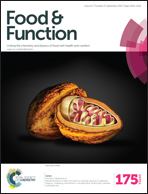Assessment of the prebiotic effect of quinoa and amaranth in the human intestinal ecosystem
Abstract
Quinoa and amaranth belong to the group of the so called “superfoods” and have a nutritional composition that confers multiple benefits. In this work, we explored the possibility of these foods exhibiting a prebiotic effect. These pseudocereals were subjected to an in vitro digestion and used as carbon sources in batch cultures with faecal human inocula. The effects on the microbiota composition and their metabolic products were determined by assessment of variations in pH, short-chain fatty acid (SCFA) production and changes in the dynamic bacterial populations by fluorescence in situ hybridization (FISH). After 48 h of incubation, the total SCFAs were 106.5 mM for quinoa and 108.83 mM for amaranth, in line with the decrease in pH. Considerable differences (p < 0.05) were found in certain microbial groups, including Bifidobacterium spp., Lactobacillus–Enterococcus, Atopobium, Bacteroides–Prevotella, Clostridium coccoides–Eubacterium rectale, Faecalibacterium prausnitzii and Roseburia intestinalis. Our research suggests that these pseudocereals can have the prebiotic potential and that their intake may improve dysbiosis or maintain the gastrointestinal health through a balanced intestinal microbiota, although additional studies are necessary.


 Please wait while we load your content...
Please wait while we load your content...